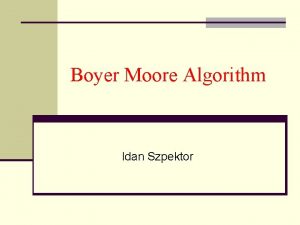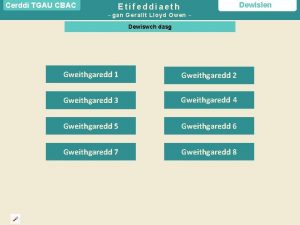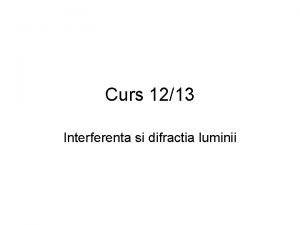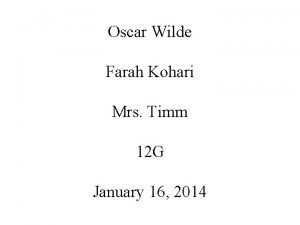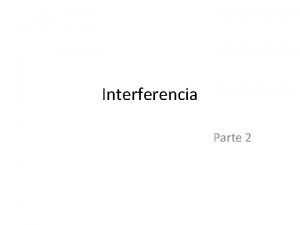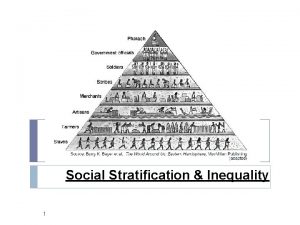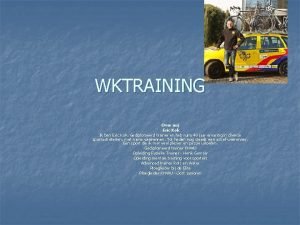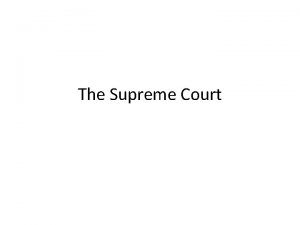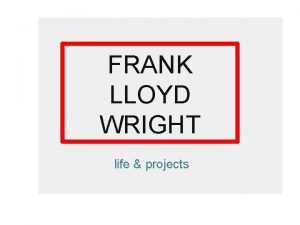Algorithms Rule Supreme Lloyd Moore ESCconf Algorithms Rule


























- Slides: 26

Algorithms Rule Supreme Lloyd Moore #ESCconf

Algorithms Rule Supreme Lloyd Moore, Senior Embedded Systems Engineer 30 years of embedded and machine vision software experience “ Code optimizations may get 2 -4 x improvement Algorithm changes can get more than 10 x ” We are going to look at how to tailor an algorithm to best fit the problem definition and improve performance #ESCconf

Agenda Definition of connectivity /blob analysis Algorithm analysis “Traditional” “Wanderer” “Single pass” approach Comparison and Summary #ESCconf

What is Connectivity Analysis Also called Blob Analysis Goal is to determine which pixels in an image are adjacent Transforms a group of individual pixels into one “object” For our discussion we will record a bounding box for the “object” #ESCconf

Comparing Algorithms Assume images are 100 x 100 pixels – simple math Algorithms will be pseudo-code and we’ll count operations Algorithms somewhat simplified for presentation Will consider memory/cache friendliness separate from operations Will consider advantages & disadvantages for image content 1 “Traditional” Algorithm 2 Consider 3 algorithm solutions: “Wanderer” Algorithm 3 “Single Pass” Algorithm #ESCconf

“Traditional” Algorithm - Problem Will use a “text book” approach to start Serves as a baseline for other algorithms Won’t make any assumptions about blobs in image Likely wouldn’t want to use this in real life #ESCconf

“Traditional” Algorithm - Outline 1 Threshold Image 2 Apply edge detection kernel 3 “Walk” image to find start of an outline 4 Follow the outline to find the blob, and update 5 bounding box Continue until all blobs found, end of the image #ESCconf

“Traditional” Algorithm - Complexity Threshold: For each pixel in image If value > Threshold then Value = 255 Else Value = 0 Edge Detection Kernel: Assume: 3 x 3 kernel, stride of 1, kernel stays inside image For each image position Ix For each image position Iy value = 0 For each kernel position Kx For each kernel position Ky value += image[Ix, Iy] * kernel[Kx, Ky] Target[Ix, Iy] = value 100 x 100 pixels = 10000 loops read + inc + write + compare + test = 4 operations read + compare + test + write = 4 operations (4 + 4) * 10000 = 80, 000 Ops (100 – 2) = 98 loops read + inc + write + compare + test = 4 operations write = 1 operation 3 loops read + inc + write + compare + test = 4 operations 6 read + 3 multiply + 3 add + 1 write = 13 operations 2 read + 1 multiply + 1 add + 1 write = 5 operations ((((4 + 13 + 5)*3 + 4) * 3 + 1 + 4) * 98 = 682, 276 Ops #ESCconf

“Traditional” Algorithm - Complexity Walk Image, find outline start: For each pixel in image If value == 255 then Trace outline(); 100 x 100 pixels = 10000 loops read + inc + write + compare + test = 4 operations read + compare + test = 3 operations Happens “rarely”, ignore call overhead (4 + 3) * 10000 = 70, 000 Ops Trace blob outline: For each pixel in border: If Image[x-1, y] == 255 then x-- (for 5 cases) If x < min_x then min_x = x (for 4 cases) If x = starting_x && y == starting_y then break Image[x, y] = 0 (erase current pixel) 5 * (3 read + multiply + add + compare + test) = 25 operati One will trigger if clause: read + add/sub + write = 3 operations 4 * (2 read + compare + test) = 16 operations Assume 25% trigger if clause: write = 0. 25 operations 4 reads + 2 compare + and + test = 8 operations 2 reads + multiply + add + write = 5 operations (25 + 3 + 16 + 0. 25 + 8 + 5) = 57. 25 Ops per border pixel Total = 80000 + 682276 + 70000 = 832, 276 operations per image + 57. 25 operations per border pixel of all blobs #ESCconf

“Traditional” Algorithm – Strengths/Weakness Strengths Weakness Simple to implement Pretty slow Simple to understand Multiple passes over image Mostly independent of image content Multiple working images Not cache friendly Original image destroyed #ESCconf

“Wanderer” Algorithm - Problem Images consist of 50 to 200 very thin blobs Imaging environment is controlled No “large” blobs Example comes from a real world optimization project Blobs were actually fibers of a material NOTE: Example images will show on a few blobs #ESCconf

“Wanderer” Algorithm - Outline 1 Threshold Image 1 2 Find Blob Start 2 3 3 Explore Blob, Updating Bounding Box 4 4 Double Check Blob Fully Explored 5 5 Reached Continue Until End of Image #ESCconf

“Wanderer” Algorithm - Complexity Threshold: Same as “Traditional” Find Blob Start: Same as “Traditional” 70, 000 Ops 80, 000 Ops Explore Blob: For each pixel in blob: Explore adjacent the 8 adjacent pixels explorer_pointer = cur_blob_start + fixed_offset if(*explorer_pointer == untouched_pixel) accumulate_pixel(this_x, this_y) operations *explorer = *explorer & constant_tag accumulate_pixel: If x < min_x then min_x = x (for 4 cases) ++pixel_count return read + write + add = 3 operations dereference + read + test = 3 operations Assume 75% of the time: 0. 75 *(2 push + call) = 2. 25 dereference + read + and + write = 4 operations 4 * (2 read + compare + test) = 16 operations Assume 25% trigger if clause: write = 0. 25 operations read + increment + write = 3 operations return = 1 operation 3 + 2. 25 + 4 + 0. 75 * (16 + 0. 25 + 3 + 1) = 27. 5 operations per blob pixel (approximately actual is 27. 4375) #ESCconf

“Wanderer” Algorithm - Complexity Explore Blob: For each pixel in blob: Move to next pixel: explore right, down & left: 4 cases assume 50% hit so count 2 cases explorer_pointer = explorer_pointer + fixed_offset read + write + add = 3 operations if(*explorer_pointer > completed_pixel dereference + read + subtract + test = 4 operations && *explorer_pointer < untouched_pixel) and + subtract + test = 3 operations cur_blob_start = explorer_pointer write = 1 operation cur_coordinate += const_offset read + add + write = 3 operations 2 * (3 + 4 + 3 + 1 + 3) = 28 operations per blob pixel Double Check Blob Fully Explored: For each pixel current blob bounding box: if(*explorer_pointer > completed_pixel operations && *explorer_pointer < untouched_pixel) cur_blob_start = explorer_pointer cur_blob_x = cur_offset % width cur_blob_y = cur_offset / width dereference + read + subtract + test = 4 and + subtract + test = 3 operations write = 1 operation 2 reads + modulus + write = 4 operations 2 reads + divide + write = 4 operations 4 + 3 + 1 + 4 = 16 operations per current blob counted pixel #ESCconf

“Wanderer” Algorithm - Complexity Threshold: Same as “Traditional” Find Blob Start: Same as “Traditional” 80, 000 Ops 70, 000 Ops Explore Blob: 27. 5 + 28 ops 55. 5 Ops per Blob Pixel Double Check: 16 ops, assume executes 3 x 48 Ops per Blob Pixel Total = 80, 000 + 70, 000 = 150, 000 operations per image + 55. 5 + 48 = + 103. 5 operations per blob pixel #ESCconf

Comparison and Summary Algorithm: Traditiona l Pixel Wanderer Ops per Image: 832, 276 150, 000 Ops per Feature: 57. 25 per blob border 103. 5 per blob area pixel OBSERVATIONS: Performance GREATLY depends on image contents Wanderer faster for empty image, worse for large blobs This application had long thin blobs, most only 1 or 2 pixels in width; blob area approximated blob border pixels in practice #ESCconf

“Wanderer” Algorithm – Strengths/Weakness Strengths 15 to 30 x faster for target image content vs commercial library Single copy of image Image altered but available Weakness Complex to implement HIGHLY dependent on image content Multiple passes over image Not cache friendly #ESCconf

“Single Pass” Algorithm - Problem Track 5 to 10 small round objects per frame Run on VERY small processors, including micro-controllers Target processor need not hold full video frame, only current pixel Example comes from a real world project Image content mostly controlled via narrow band optical filter #ESCconf

“Single Pass” Algorithm - Outline 1 For each pixel in the image 2 Threshold the pixel and detect segment start and ends 3 When a segment is complete add it to the connecting blob structure #ESCconf

“Single Pass” Algorithm - Complexity Setup variables: forming_vector = false pixel_scanner = image_start current_x = current_y = 0; Insert blob line: For each blob if this_y == last_y + 1 if min_x >= blob_min_x or max_x <= blob_max_x blob_last_y = this_y blob_min_x = min_x blob_max_x = max_x if min_x < box_min_x = min_x if max_x > box_max_x = max_x write = 1 operation read + write = 2 operations 2 writes = 2 operations 1 + 2 = 5 operations per image Assume 10 blobs at all times (worst case) 2 read, add, compare, test = 5 operations 2 read, compare, test, or = 5 operations 2 read, compare, test = 4 operations read + write = 2 operations <=Only for 1 blob 2 read, compare, test = 4 operations <=Only for 1 blob read + write = 2 operations <=Only for 1 blob, 50% 10 * (5 + 4) + (2 + 2 + 4 + 0. 5) = 155 operations per blob line #ESCconf

“Single Pass” Algorithm - Complexity Walk the image: For each pixel in the image: if *pixel_scanner > threshold Assume: 1% hit image is mostly black if not forming_vector starting_x = max_x = current_x starting_y = current_y forming_vector = true else max_x = current_x else if forming_vector insert_blob_line() forming_vector = false ++pixel_scanner; ++current_x; ++current_y if current_x > image_width if forming_vector insert_blob_line() ++current_y; current_x = 0; forming_vector = false 100 x 100 pixels = 10000 loops dereference + read + compare + test = 4 operations read + compare + test = 3 operations <=Take worst case read + 2 write = 3 operations read + write = 2 operations write = 1 operation read + write = 2 operations <=Not worst case read + compare + test = 3 operations <=Not worst case from previous slide <=Counted per blob line write = 1 operation <=Not worst case 3* (read + increment + write) = 9 operations read + compare + test = 4 operations read + compare + test = 3 operations <=Image Row read + increment + 2 write = 4 operations <=Image Row write = 1 operation <=Image Row 10000 * 4 + 0. 01 * (3 + 2 + 1) + (9 + 4) + 10 * (3 + 4 + 1) = 40093. 09 => 40, 093 + 5 setup = 40, 098 ops per image + 155 ops per blob line #ESCconf

“Single Pass” Algorithm – Strengths/Weakness Strengths Weakness Extremely fast, though no direct benchmark Performance suffers with large number of blobs Single pass through image, and only need to have one pixel of the image at any time Have to deal with combining blob fragments in some cases; did not address that here as didn’t need it for this particular case Original image untouched Simple to implement Very cache friendly #ESCconf

Comparison and Summary Algorithm: Traditiona l Wonderer Single Pass Ops per Image: 832, 276 150, 000 40, 098 Ops per Feature: 57. 25 per blob border pixel 103. 5 per blob pixel 155 per blob line OBSERVATIONS: Note ops per image constantly goes down, consider an empty image Most blob lines will have many pixels so 155 ops per line isn’t that bad Consider a completely white image: single pass still better Actual implementation also had noise filter to consolidate blob lines #ESCconf

Final Thoughts Matching the algorithm to the expected use case and input can greatly improve performance These gains are complimentary and additive to other optimization techniques Consider radically different approaches – “Single Pass” cannot be clearly evolved from “Traditional” or “Wanderer” algorithms ALWAYS measure actual performance and use a wide variety of input #ESCconf

Speaker/Author Details Http: //FSStudio. com Lloyd. Moore@FSStudio. co m #ESCconf

Thank You! Questions? @ESC_Conf #ESCconf
 Galil rule
Galil rule Dr sarah lloyd
Dr sarah lloyd Andrew lloyd webber facts
Andrew lloyd webber facts Lloyd kwast
Lloyd kwast Etifeddiaeth by gerallt lloyd owen
Etifeddiaeth by gerallt lloyd owen Lloyd davies position
Lloyd davies position Trace fossil
Trace fossil Oglinda lui lloyd
Oglinda lui lloyd Lloyd morgan y la ley de la parsimonia
Lloyd morgan y la ley de la parsimonia Lorenz lloyd fischer
Lorenz lloyd fischer Constance lloyd
Constance lloyd Facts about william lloyd garrison
Facts about william lloyd garrison Andy lloyd
Andy lloyd Frank lloyd wright apush
Frank lloyd wright apush William lloyd garrison apush
William lloyd garrison apush Espejo de lloyd
Espejo de lloyd Frank lloyd wright bridge
Frank lloyd wright bridge Lloyd quarterman
Lloyd quarterman Matthew greer miami
Matthew greer miami William lloyd garrison jr new deal
William lloyd garrison jr new deal Dr mike lloyd
Dr mike lloyd Classificazione fibre nervose lloyd
Classificazione fibre nervose lloyd Lloyd ansell
Lloyd ansell Barbiere di siviglia trama
Barbiere di siviglia trama Constance lloyd
Constance lloyd Lloyd braithwaite theory
Lloyd braithwaite theory Eric kok delta lloyd
Eric kok delta lloyd
